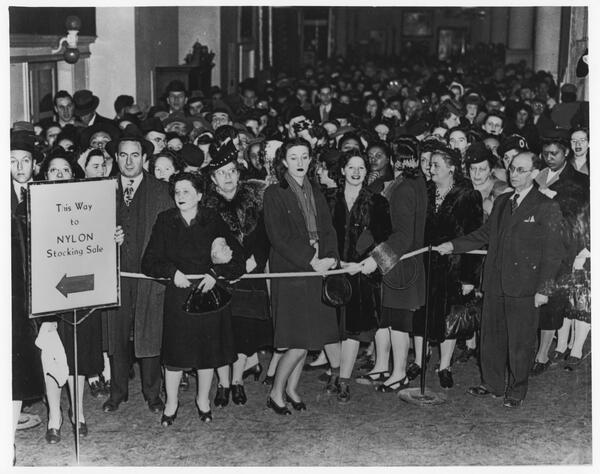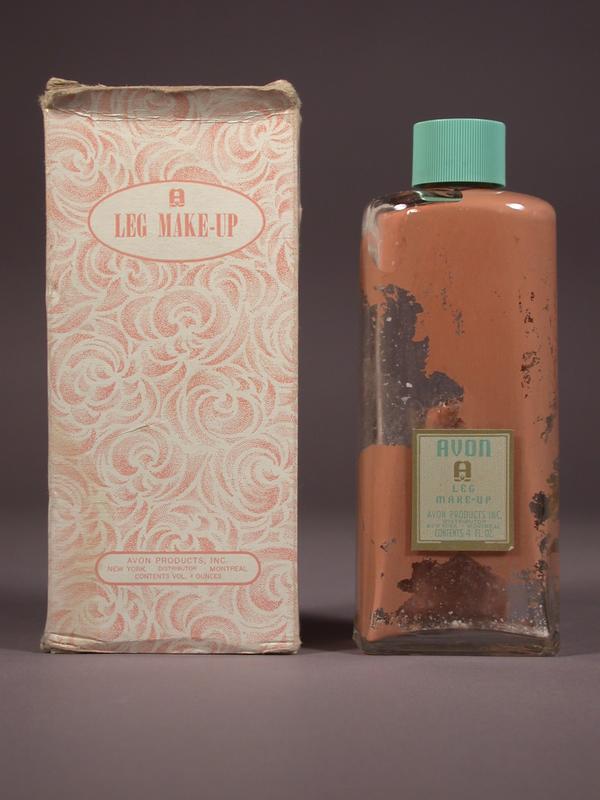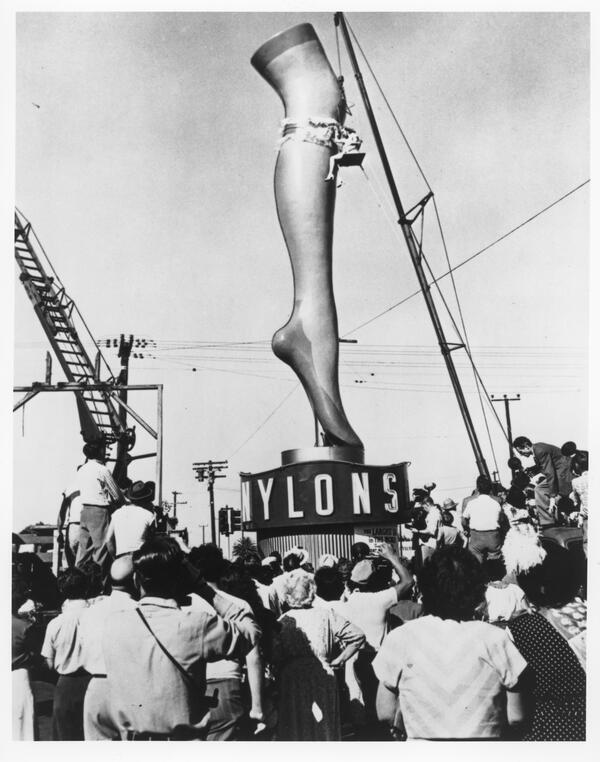As a new addition to the Hagley Museum and Library team as the summer reference intern, I took some time in my first week to acclimate myself to the collections.
Looking through the Digital Archives, I found many interesting pictures contained within Hagley’s collections, but there was a running theme that kept catching my eye. Consistently, as I was scrolling through the available resources, photographs with large groups of people kept popping up, with titles such as “Crowds buying nylon stockings” and “Sales frenzy of a crowd gather for nylon.”
Specifically, the words “frenzy” and “nylon” used in the same sentence were comical to me. At the time, I only had two connections to nylon: a vague recollection of seeing the word on some of my clothes tags and what my grandmother has always worn rather than socks.
 While style crazes are not a new thing, I had a tough time believing that anyone was lining up with such fervor for a pair of stockings. After some digging, I found out that I could not be more mistaken because, in the 1940s, eager shoppers waited in huge crowds to get their hands on the next best clothing item—nylon stockings.
While style crazes are not a new thing, I had a tough time believing that anyone was lining up with such fervor for a pair of stockings. After some digging, I found out that I could not be more mistaken because, in the 1940s, eager shoppers waited in huge crowds to get their hands on the next best clothing item—nylon stockings.
Since this was such an intriguing topic to me, I began to do some research and found out that nylon is a synthetic fiber invented by DuPont Company scientist, Wallace H. Carothers. Now, it is a widely used invention found in all sorts of clothing items from socks to sweaters to bathing suits.
After the creation of nylon, its popularity when introduced at the World’s Fair in New York was unanticipated, especially for its use in stockings. This is noted by scholar Dr. Isabelle Marina Held in her Hagley History Hangout episode. The image to the right depicts women at the World’s Fair modeling nylon stockings; DuPont scientists also showed visitors the process to make nylon.
From the late 1930s to early 1940s, stockings became an increasingly important accessory. As Emily Spivack’s "Stocking Series” notes, “Hemlines were rising throughout the 1930s, and stockings, made at that time from silk or rayon, had become an essential component to a woman’s wardrobe, even though they were delicate and prone to runs.” Nylon was intended to be a more durable choice.
Within a collection of press releases celebrating the 50th anniversary of nylon’s invention, DuPont recognized nylon’s “ability to spring back to its original shape after being stretched out or crushed.” The fabric’s ability to hold its original shape even when worn contributed to its popularity as a material for stockings, preferred over the time period’s alternatives of silk or rayon.
At first, the only women who could get their hands on the novelty worked at DuPont or had husbands who did. Come 1940, nylons finally went on the market and lived up to their reputation by selling out in two days.
The image below from the DuPont Company External Affairs Department depicts the frenzy which originally piqued my interest in this phenomenon. In the photograph, a huge crowd of both men and women eagerly wait for the sale to begin, standing behind a rope with sign that reads, “This Way to Nylon Stocking Sale.”

Despite the public popularity of nylons, they left the market in 1942 so that the material could be used in support of the war effort. Nylon production transitioned to making various products needed as the Unites States entered World War II such as parachutes and ropes.
 While nylon production funneled into products for the war, women still longed for the luxury of their nylon stockings. They quickly got creative to achieve the same look that the stocking gave a wearer.
While nylon production funneled into products for the war, women still longed for the luxury of their nylon stockings. They quickly got creative to achieve the same look that the stocking gave a wearer.
One of the solutions included within the “Stocking Series” that rose to popularity were “liquid stockings.” Women would use foundation like makeup products to cover their legs to mimic the look of nylon stockings. For an extra touch, users would take an eye liner pencil and draw a line down the back of the leg, creating the illusion of the seam highly associated with the stockings. This trend even sparked the creation of leg makeup bars in department stores where women could get this beauty service performed, with a product like the Avon Leg Makeup (see right) included within Hagley’s collection. Despite this solution, some women, desperate to have the stockings they knew before the war turned to the black market to buy the highly envied product at a marked-up rate.
Once the war ended in 1945, it took some time for nylon production to switch back to non-war goods and manufacture enough supply to sell. The demand for nylon stockings mirrored the popularity and sales of when they first went on sale in 1940.

 Following its hiatus due to war production, large crowds of people showed up to buy the accessory. The sheer number of customers outnumbered the nylons available for sale. For example, in Pittsburgh 40,000 people waited to try and buy a pair of only 13,000 available nylons. From these large turnouts, newspapers across the country coined the reaction as the “nylon riots” as these reactions occurred from New York to San Francisco. Despite the craze, women able get one of the coveted pairs of stockings were happy to have their beloved accessory once again.
Following its hiatus due to war production, large crowds of people showed up to buy the accessory. The sheer number of customers outnumbered the nylons available for sale. For example, in Pittsburgh 40,000 people waited to try and buy a pair of only 13,000 available nylons. From these large turnouts, newspapers across the country coined the reaction as the “nylon riots” as these reactions occurred from New York to San Francisco. Despite the craze, women able get one of the coveted pairs of stockings were happy to have their beloved accessory once again.
I cannot say I would personally line up with thousands of other people for a pair of stockings; however, I found this little piece of fashion history an interesting glimpse into the popular accessories of the past which lives on with people like my grandmother and in the Hagley Museum and Library collections.
Delaney Runge is the Reference Intern at Hagley Museum and Library. She recently graduated from Washington College with a B.A. in English.
